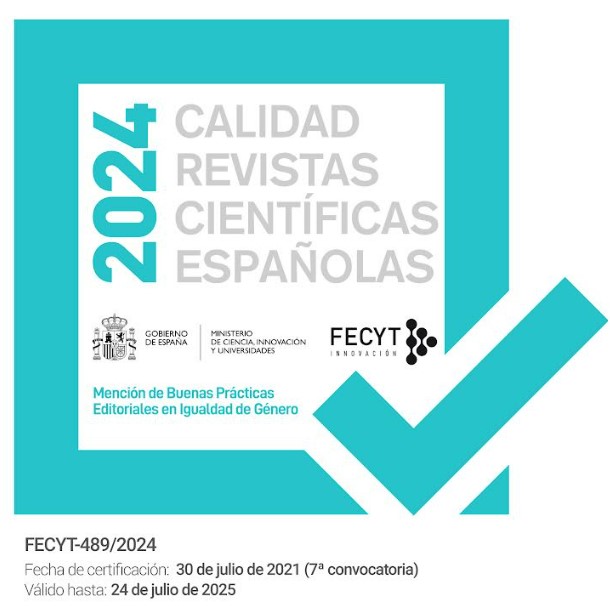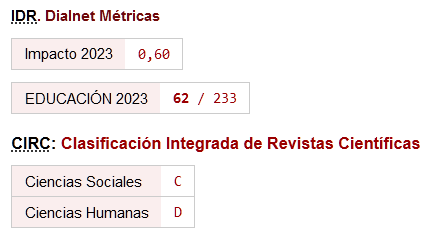Constructing gender in Childhood: living in a family or in an institution
Abstract
This investigation attempted to clarify whether the social construction of gender in a family is performed in a similar way to the social construction of gender in institutionalized childhood. The research was carried out among a sample group of 50 people; 20 of whom were caregivers who work in a foster home. The other members of the sample group belonged to families with young children who had similar ages to those of the children in the foster home in Cáceres. The instrument used for collecting information was the Bem Sex Role Inventory. Although the members of the sample group in this research are adults, the focus is on childhood. Accordingly, the purpose of the inventory was not to obtain a self-description of the person, as was intended in the original, but focused on the children. The results show that the parents are closer to the androgynous model, while the caregivers tend more towards the feminine one.
Downloads
References
Arana, J., & Carrasco, J. L. (1980). Niños desasistidos del ambiente familiar. Madrid: Karpos.
Bem, S. L. (1981). Bem sex-role inventory: Professional manual. Palo Alto, CA: Consulting Psychologists Press.
Bem, S. L. (1974). The measurement of psychological androgyny. Journal of Consulting and Clinical Psychology, 42(2), 155–162.
Benz, C. R., Pfeiffer, I., & Newman, I. (1981). Sex role expectations of classroom teachers, grades 1–12. American Educational Research Journal American Educational Research Journal, 18(3), 289–302.
Berger, P. L., & Luckmann, T. (1991). The social construction of reality: A treatise in the sociology of knowledge. London: Penguin Books.
Blaise, M. (2005). A feminist poststructuralist study of children ‘doing’ gender in an urban kindergarten classroom. Early Childhood Research Quarterly, 20(1), 85–108.
Butler, J. (2007). Gender trouble: Feminism and the subversion of identity. New York: Routledge.
Connell, R. (1995). Masculinities. Berkeley: University of California Press.
Davies, B. (2003). Shards of glass: Children reading and writing beyond gendered identities. Cresskill, N.J.: Hampton Press.
Davies, B. (1997). The subject of post-structuralism: A reply to Alison Jones. Gender and Education, 9(3), 271–283.
Davies, B., & Lucena, E. (1994). Sapos y culebras y cuentos feministas: Los niños de preescolar y el género. Madrid: Ediciones Cátedra.
Davies, B., & Banks, C. (1992). The gender trap: A feminist poststructuralist analysis of primary school children's talk about gender. Journal of Curriculum Studies Journal of Curriculum Studies, 24(1), 1–25.
Fagot, B. I., & Leinbach, M. D. (1989). The young child's gender schema: Environmental input, internal organization. Child Development, 60(3), 663–72.
Fernández, J. (1996). Varones y mujeres: desarrollo de la doble realidad del sexo y del género. Madrid: Pirámide.
Francis, B., & Skelton, C. (2001). Investigating gender: Contemporary perspectives in education. Buckingham; Philadelphia, Pa.: Open University.
Galet, C., & Ameijeiras, R. (2005). Planificación y evaluación en educación social: protección del menor: marco jurídico y educativo. Cáceres: Cenproex.
García-Mina, A. (1997). Análisis de los estereotipos del rol de género: Validación transcultural del inventario del rol sexual. Madrid: Universidad Pontificia Comillas.
Haig, D. (2004). The inexorable rise of gender and the decline of sex: Social change in academic titles, 1945–2001. Archives of Sexual Behavior, 33(2), 87–96.
Halim, M. L., & Ruble, D. (2010). Gender identity and stereotyping in early and middle childhood. In J. Chrisler & D. McCreary (Eds.), Handbook of gender research in psychology (pp. 495–525). Springer: New York.
Hedegaard, M. (2014). The significance of demands and motives across practices in children's learning and development: An analysis of learning in home and school. Learning, Culture and Social Interaction, 3(3), 188–194.
Hoffman, R., & Borders, L. (2001). Twenty-five years after the Bem sex-role inventory: A reassessment and new issues regarding classification variability. Measurement & Evaluation in Counseling & Development (American Counseling Association), 34(1), 39–55.
Jayme, M. (2002). La psicología del género en el siglo XXI. Clepsydra: Revista de Estudios de Género y Teoría Feminista, 1, 47–60.
Jones, A. (1997). Teaching post-structuralist feminist theory in education: Student resistances. Gender and Education, 9(3), 261–269.
Lamas, M. (1999). Usos, dificultades y posibilidades de la categoría género. Papeles de Población, 5(21), 147–178.
Money, J. (1955). Hermaphroditism, gender and precocity in hyperadrenocorticism: Psychologic findings. Bulletin of the Johns Hopkins Hospital, 96(6), 253–264.
Renold, E. (2004). 'Other' boys: Negotiating non-hegemonic masculinities in the primary school. Gender and Education, 16(2), 247–265.
Rodríguez Menéndez, M. C. & Peña Calvo, J. V. (2005). Identidad de género y contexto escolar: Una revisión de modelos. Revista Española de Investigaciones Sociológicas, 112(1), 165–194.
Skelton, C. (2001a). Schooling the boys: Masculinities and primary education. Buckingham; Philadelphia: Open University Press.
Skelton, C. (2001b). Typical boys? Theorizing masculinity in educational settings. In B. Francis, & C. Skelton (Eds.), Investigating gender: Contemporary perspectives in education (pp. 164–176). Buckingham; Philadelphia: Open University.
Stoller, R. J. (1964). A contribution to the study of gender identity. The International Journal of Psycho-Analysis, 45, 220–226.
Swain, J. (2000). 'The money's good, the fame's good, the girls are good': The role of playground football in the construction of young boy's masculinity in a junior school. British Journal of Sociology of Education, 21(1), 95–109.
Vega, V. C. (2007). Adaptación argentina de un inventario para medir identidad de rol de género. Revista Latinoamericana de Psicología (Bogotá), 39(03), 537–546.












